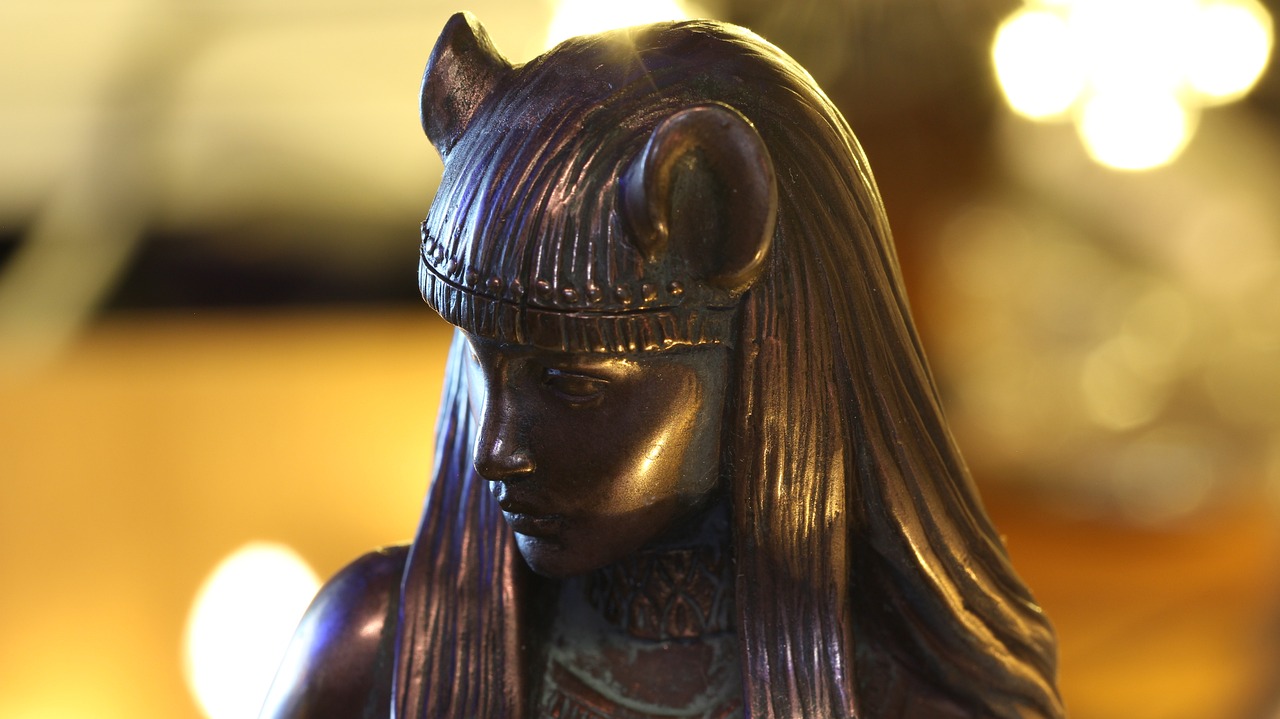The captivating and at times exotic nature of ancient Egyptian spirituality is epitomized in the deity Bastet, a goddess often represented in artwork as a seated cat adorned with various sacred symbols like a scarab atop her head. In a poised yet watchful demeanor reminiscent of real felines, the divine Bastet embodies a realm steeped in enigmatic beliefs from ancient times.
Bastet: The Lioness and the Cat
Bastet’s primary worship site is situated in Bubastis, a significant city located in the southeastern region of the Nile Delta. Nonetheless, the earliest references to Bastet are discovered in the chambers beneath the renowned Djoser step pyramid at Saqqara, near Memphis. Archaeological finds from the 2nd dynasty (circa 2800 BCE) include numerous fragments of stone vessels from burial sites, with some inscribed mentions of various deities, including Bastet illustrated as a woman with the head of a lioness. Evidence suggests that Bastet may have initially functioned as a deity linked to the royal court, possibly connected to the name of an ointment jar, b#s.t., indicating her association with attributes of protection and regality that align with a lioness’s characteristics.
The first explicit evidence of Bastet in Bubastis comes from the reign of Pepi I during the 6th dynasty (around 2270 BC). This is indicated by a decorated door lintel from the king’s Ka-temple, showing both Bastet and Hathor. Again, she is illustrated as a woman with a lioness head. Additionally, tomb stelae from the elite cemetery in Bubastis during this period reveal titles belonging to administrators of the Bastet temple, leading to the conclusion that a temple dedicated to this goddess existed by the end of the Old Kingdom.
The migration of Bastet’s worship from the early dynastic capital of Memphis to Bubastis remains somewhat uncertain. One theory proposes that in the early 3rd millennium, groups of lions inhabited the semi-desert regions bordering the Delta. The seasonal lake at Wadi Tumilat provided an ideal habitat for these creatures. The Delta, boasting abundant cattle essential for a burgeoning centralized state, also offered a tempting hunting ground for lions. Observing the hunting tactics of lions, especially lionesses, known for their collaborative hunting skills, might have inspired the veneration of these majestic animals.
The Evolution of Bastet’s Image
From her early representations to the later New Kingdom, Bastet is predominantly depicted as a lioness. The iconic portrayal of her as a domestic cat evolved over time, reflecting the subtle shifts in religious perspectives throughout Egyptian history. Notably, her dual essence as both lioness and cat is frequently illustrated through her association with Sekhmet, another lioness goddess. This duality is highlighted in ancient texts, such as the “Loyalist teaching” of the 12th dynasty, which describes the ideal qualities of a king likening them to both Bastet, protector of the lands, and Sekhmet, punisher of wrongdoers.
As time progressed, the character of feline goddesses, especially Bastet, transformed further. Cats began to represent a softer, more approachable facet of the goddess. This reimagining likely contributed to her eventual depiction as a domestic cat, thus reducing the threat associated with a lioness. Notably, during the Middle Kingdom, there are the first artistic representations of cats, similar to their wild counterpart, depicted as beloved pets in tomb artworks.
The popularity of Bastet’s worship surged from the New Kingdom onward, particularly during the 1st millennium BC, as her influence expanded beyond Egypt into the Mediterranean region. Temples dedicated to Bastet in Sakkara and Alexandria signify the goddess’s growing cosmopolitan appeal.
Celebrating Bastet: The Bubastis Festival
Around 450 BCE, the Greek historian Herodotus provided an account of the temple and worship of Bastet, particularly highlighting the elaborate festival held in her honor. He recounted that visitors to Bubastis would travel via boats filled with people, all engaging in music and joyous celebration. They would stop by every city along their journey, entertaining themselves with singing and mockery, before reaching Bubastis to partake in grand sacrifices and monumental feasting. It was said that the amount of wine consumed during this festival surpassed that of the entire year combined, with gatherings of up to seventy thousand individuals, not including children.
Scholars often associate the ecstatic nature of these festivities with the reproductive behaviors of cats, suggesting that the celebrants sought to channel fertility in their own lives. Illustrative evidence points to wild displays of joy that broke societal norms, which were believed to appease Egyptian goddesses, particularly those embodying lioness attributes like Bastet and Sekhmet, and even Mut and Hathor.
Lioness deities were perceived as both fierce and nurturing, representing duality in their character. They were often related to the sun god Ra, recognized as “Daughter of Ra” or “Eye of Ra.” One interpretive tale, recounted on several demotic papyri from the 2nd century BCE, illustrates the narrative of Ra’s daughter, who, in her rage, roamed the deserts, instilling fear. To quell her anger, Ra dispatches Thot, who must soothe her throughout the journey back to Egypt by employing music, dance, and merriment—experiences that resonate with the joyful Bacchanal atmosphere of the Bubastis festival.
The event also encompassed local traditions, as evident in Papyrus Brooklyn 47.218, a manuscript from the 7th century BCE detailing legends surrounding the Delta. In one tale, Bastet triumphs over Seth to recover Horus’s eye, symbolizing her protective nature. Imagining the deity traveling in her sacred barque along the Isheru canals of Bubastis evokes the climactic religious observance of the festival, marking a moment of collective fervor among the throngs of pilgrims visiting in reverence each year.



